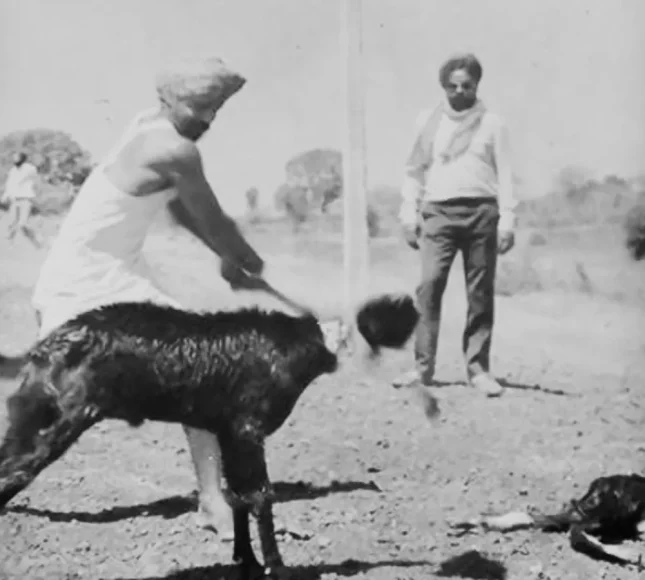JHATKA, the Sikh mode of killing an animal for food, also stands for the meal of an animal or bird so killed. Derived, etymologically, from jhat, an adverb meaning instantly, immediately or at once, jhatka signifies a Jerk, snap, jolt or a swift blow. For Sikhs jhatka karna or jhatkaund means to slaughter the animal instantaneously, severing the head with a single stroke of any weapon or killing with gunshot or electrocution. The underlying idea is to kill the animal with the minimum of torture to it.Jhatka is opposed to kuttha that is meat of an animal slaughtered by a slow process in the Muslim way known as halal (lit. legal, legitimate, lawful).
Kuttha is a participle derived from the Punjabi verb kohna (lit. to torture). While slaughtering for food, a Muslim must incise the throat of the animal to the accompaniment of the exclamation of the kalima, the Islamic formula meaning “By the name of Allah, the Merciful and Compassionate.” For jhatka, a Sikh while delivering the blow may utter Sat Sri Akal (lit. True is the Timeless Lord), which is both a Sikh war slogan and a salutation, but there is no idea of sacrifice or ritual involved in such utterance, and it is not mandatory either.Sikhism does not sanction sacrificial or ritual killing.
Historically, there is no positive injunction enforcing jhaika mode of slaughter laid down by the Gurus.However, Guru Gobind Singh, when manifesting the order of the Khalsa in 1699, enjoined upon Sikhs to abstain from kuttha or halal meal introduced by the Muslim ruling class. That many high ranking Hindus had succumbed to the practice of eating kuttha is evidenced from a verse of Guru Nanak`s in Asa Ki Var: “They eat kuitha of goats killed with the pronouncement of alien words, i.e. kalima, but do not allow anyone to enter their cooking square (to guard against pollution by touch)…”Instructions regarding jhatka mode of slaughter are contained in various Rahitndmas or codes of conduct for the Sikhs, and the Sikh chronicles written during the eighteenth and nineteenth centuries.
They all affirm that Guru Gobind Singh made the taking of kuitha one of the four major kurahits, or violations of the Sikh code of conduct. However, two of these sources say positively: “Kill the male goal in the jhatka way if you want to eat, but do not ever look at any other type of meat” {Rahitnama of Bhai Desa Singh,), and “Slaughter male goats through jhalka and cat; do not go near carrion or kutthd” (Ratan Singh Bharigu, Prdchm Panth Prakash). Rahitnama of Bhai Desa Singh also enjoins the slaughtering to be carried out away from the kitchen.Traditionally, it is also to be away from a holy spot.
The mention of male goat in the chronicles is only illustrative and does not exclude oilier animals or birds the flesh of which the Sikhs usually cat. Not many Sikhs are habitually meatcaters. Their staple diet mainly consists of cereals, pulses, vegetables and milk products. Some of their sects even practise strict vegetarianism. The Sikh religion however neither recommends nor prohibits the eating of flesh.
During their own rule in Punjab, the Sikhs practised tolerance and never tried to enforce jhatka on their Muslim subjects. But during the British rule, the predominating Muslim community in western Punjab opposed jhatka.Even at government level, jhatka was not allowed in jails and Sikh detenues during the Akali movement and after had to resort to protests and agitations to secure this right. One of the terms in the settlement between the Akalis and the Muslim dominated Unionist government in the Punjab in 1942 was that the use of jhatka meat would be permissible in public institutions.
References:
1. Sabadarth. Sri Guru Cranth Sahib. Amritsar, 1959
2. Sikh Rahit Maryada. Amritsar, n.d.
3. Padam, Piara Singh, cd., Rahitname. Amrilsar, 19H9
4. Bhangn, Ralan Singh, Prachin Pnnl.h Prakash. Amritsar, 1962







